Abstract
In this study, the effects of multi-perforated gypsum boards on floor impact noises were investigated in a box-type test building and an actual apartment building. In a box-type test building with 150 mm thick slab, various design factors such as hole pattern, hole size, opening ratio, backing, or finishing materials were considered. Heavy-weight impact sources of bang machine and rubber ball were employed. The test procedure followed KS F 2810-2, and then, a single number rating was derived in accordance with KS F 2863-2. As a result, reduction of heavy-weight impact noise by applying multi-perforated gypsum boards as a ceiling material was expected maximumly up to 3 dB for bang machine and 5 dB for rubber ball. Regarding the reduction of floor impact sounds at frequencies above 125 Hz, the installed area of the employed multi-perforated gypsum board was shown as the most dominant factor. Then, an in situ investigation using standard impact sources and five children was carried out in an actual living space of an actual apartment dwelling unit. Comparing before and after installation of multi-perforated gypsum board, 1–2 dB of heavy-weight impact noises was reduced. In addition, subjective impressions of the reduced impact noise were discussed based on the field questionnaire survey using actual children’s running situations.
1. Introduction
The density of cities around the world is increasing with urbanization, and the proportion of apartment houses is increasing accordingly [1]. Moreover, the increase in home time due to the COVID-19 is leading to an increase in noise pollution, such as floor impact sounds in indoor acoustic environments [2]. Therefore, it is necessary to improve acoustic performance for the sustainability of indoor acoustic environments. Recently, ISO/TS 19488 was published to classify acoustic performance schemes of dwelling houses [3,4]. This standard specifies acoustic quality classes for living spaces in terms of airborne and impact sound insulation generated within a building, airborne noise insulation against exterior noise such as traffic or industry sources, noise from building service equipment, and so on. However, classifications on impact noise insulation performance using heavy-weight sources such as bang machines or rubber balls have not been completed within ISO/TS 19488 [5,6]. In several countries with a high proportion of multi-story apartment residential housing, many residents are suffering social problems based on heavy-weight impact sounds among residents [7,8,9]. Therefore, it is urgently needed to develop both effective evaluation criteria and effective reduction technology on heavy-weight impact sounds.
In South Korea, a concrete slab with a thickness of 210 mm or more has been forced to be used for building an apartment complex for securing minimum performance of isolating floor impact noises since 2013 [10]. However, many apartment buildings built before the regulation entered into force had relatively thinner concrete slabs, for example, less than 150 mm in the 1990s and 180 mm in the early 2000s [11]. For retrofitting the existing apartment buildings to improve isolating performances of floor impact noises, much research has been carried out mainly in terms of floor treatments over concrete slab [12,13]. Especially, approaches with resilient layers in-between concrete slab and screed are the most popular method directly to reduce floor impact noises [14,15,16]. However, there are limitations to improve reducing the performance of impact noises only with floor treatment under a floating floor system with a limited total thickness (about 110 mm including resilient materials, leveling light-weight concrete, and finishing mortar) [17,18,19]. Therefore, it is needed for both new construction and remodeling purposes to develop additional architectural treatments such as ceiling and wall finishes in receiving rooms except for floor structure [20].
Due to the Fire Services Act in South Korea, the ceiling structures should have a backing air-cavity of 170–200 mm beneath the concrete slab. Therefore, light-weight steel structures or wooden frames are generally used with gypsum board finishing. Usually, a flat-type ceiling is employed, but a coffered-type ceiling is often employed to maximize living room space despite the limited floor height. Some research tried to evaluate floor impact sounds with increasing sound absorption performance using infill sound absorbers or with increasing sound isolating performance using thicker and heavier materials [21,22]. However, this gypsum board ceiling with a backing air cavity usually yields amplification of low-frequency impact sounds at around 63 Hz [23]. Thus, reducing performances of heavy-weight impact sounds are commonly getting worse by 2–3 dB in terms of single-number quantity (Li,Fmax,AW) [24]. To avoid this phenomenon, a ceiling structure with no hanging bolts or resonant sound absorber has been suggested [19]. Recently, the use of a multi-perforated gypsum board instead of a normal gypsum board could contribute to improving isolating performances of heavy-weight impact noise by 1–2 dB [25]. However, there was no practical application case using a multi-perforated gypsum board ceiling to reduce floor impact noises in an actual living condition with a subjective response test. Therefore, it is necessary to derive optimized practical methods to improve the floor impact sound performance by considering various treatments such as thickness, pattern, or infill materials applicable to actual ceiling construction for retrofitting the existing apartment buildings.
In this study, the effects of multi-perforated gypsum board profiles on reducing heavy-weight impact noises were investigated in a box-type test building. Based on the experiment results, optimization of module profile was carried out to be applicable for the existing rooms as an additional treatment. Thus, practical installation and in situ measurement were conducted to verify a reduction performance of the developed profile, including a field subjective questionnaire survey.
2. Materials and Methods
2.1. The Specimen Profile using Multi-Perforated Gypsum Boards
Three types of multi-perforated gypsum boards, as shown in Table 1, were considered based on random-incidence sound absorption coefficient results: Type A profile (mean sound absorption coefficient as NRC 0.50, opening ratio 8.7%, sound absorption at 125 Hz: 0.55), Type B profile (mean sound absorption coefficient as NRC 0.68, opening ratio 17.8%, sound absorption at 125 Hz: 0.55), and Type C profile (mean sound absorption coefficient as NRC 0.44, opening ratio 5.6%, sound absorption at 125 Hz: 0.49). For increasing sound isolation performance of the ceiling, effects of gypsum board thickness on impact noises were tested with a range of 9.5, 12.5, and 19 mm. Then, replacing the existing gypsum board ceiling with the multi-perforated gypsum board was considered by ceiling parts, center, or side. The effect of infill sound absorbers such as glass wool was also investigated. Based on the test results with various panel thicknesses, the panel-type module was designed to attach to the existing rooms without removal of the existing structure.

Table 1.
Pattern types of multi-perforated gypsum boards (NRC: Noise Reduction Coefficient, averaged sound absorption coefficient at 125, 250, 500, and 1000 Hz).
Figure 1 shows the section of the initial profiles using multi-perforated gypsum boards for the experiments in the box-type test building. Figure 2 shows the specimen profile for in-situ application of the actual apartment building with pictures of the making process.

Figure 1.
Sections of the test profiles using multi-perforated gypsum boards (GW—infill glass wool; K—unit for density in kg per m2; T—unit for thickness in mm). (a) Section for Type A, B, and C profiles; (b) section for Type D profile.
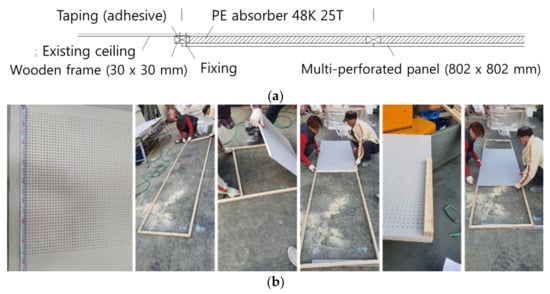
Figure 2.
Specimen profile for in-situ application with picture of making process (PE—polyester). (a) Section profile; (b) making process.
2.2. Experiment I
2.2.1. The Box-Type Test Building
The box-type test building simulates a typical living room (a house with an area of 59 m2 for exclusive use) with a width of 4.5 m and a length of 5 m with two stories. The concrete slab thickness of the test room was 150 mm. The floor structure consists of light-weight leveling concrete of 40 mm thick and finishing mortar of 40 mm thick for simulating old apartment buildings built before the early 2000s. Figure 3 shows the pictures of the test building’s appearance and inside of the receiving room. Figure 3c indicates the five source positions on the upper floor.
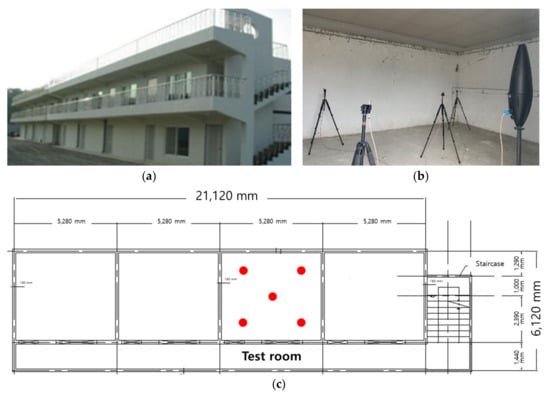
Figure 3.
The box-type test building and inside of the receiving room. (a) Exterior appearance; (b) inside of the receiving room; (c) position of the impact sources (red circles).
2.2.2. Experimental Configurations
Table 2 shows the experimental configuration in the box-type test building. Two types of ceiling finishing methods were employed as flat and coffered shapes. For the test cases with flat-type ceilings, three variables of thickness of gypsum boards, perforation pattern, and infill sound absorber were considered. The thickness of gypsum boards for the flat-type ceiling was 9.5, 12.5, and 19 mm. Three types of Type A, Type B, and Type C profiles were applied as different perforation patterns. For evaluation of the infill sound absorber effect, glass wool with density of 24 kg/m3 and thickness of 50 mm was employed as a backing material. For the test cases with coffered-type ceiling, four variables of the installation location of perforated gypsum boards, type of adding specimen, surface finishing method, and other additional treatments were considered. Three perforated ceiling cases in all areas, central area, corner area, and non-perforated ceiling case were considered, as shown in Figure 4. Two types of adding perforated ceiling specimen with Type A profile of thickness of 50 mm and Type D profile of thickness of 50 and 100 mm were installed on the central coffered ceiling area, as shown in Figure 5. Wallpaper and water-based painting were considered ceiling finishing method. Additionally, perforation on backing gypsum boards, removal of backing non-woven fabric, and additional installation on walls and corners were considered.

Table 2.
Experimental configuration in the box-type building.

Figure 4.
The coffered ceiling details. (a) Non-perforated gypsum boards; (b) perforated gypsum boards only on ceiling corners; (c) perforated gypsum boards only on ceiling center; (d) perforated gypsum boards on all ceilings.
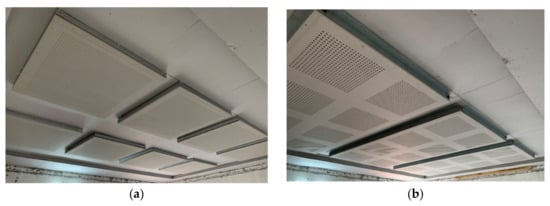
Figure 5.
Additional installation of the test modules on coffered ceiling. (a) Type A profile; (b) Type D profile.
2.3. Experiment II
2.3.1. The Actual Apartment Building
Based on experiment I, a practical experiment was carried out in an actual apartment building for verification of the prior experimental results. The actual apartment building (a house with an area of 85 m2 type for exclusive use), which was built in 2000 and located in Incheon, South Korea, was prepared for the experiment. The sound receiving test room has three bedrooms and one living room connected to the kitchen and dining room, as shown in Figure 6a. The floor of the sound source test rooms was covered by protective sheets because the rooms are currently occupied, as shown in Figure 6b. In addition, the presence of the noise protection mattress of 40 mm thick with PE foam was compared for covering the floor of the sound source room. The composition of the floor structure is unknown, but the thickness of the concrete slab is presumed to range between 100 and 150 mm in consideration of the apartment construction period.
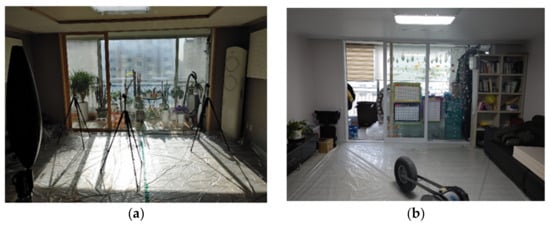
Figure 6.
Pictures of the receiving and sound source rooms of the actual apartment building. (a) Sound receiving test room; (b) sound source test room.
2.3.2. Experimental Configurations
Figure 7 shows the ceiling plan and interior elevations with the installed test specimen modules. Based on the results from Experiment I, Type A pattern was chosen. In the living room space of the actual apartment building (room volume was about 45 m3), the modules were installed on the sides of ceiling surfaces such as a coffered ceiling (14 modules) and the opposite upper walls (7 modules). In total, surface area of the test specimen was 13.44 m2. Floor impact noise measurements were carried out before and after the installation of the test specimen modules. In addition, the floor covering mattress was tested.
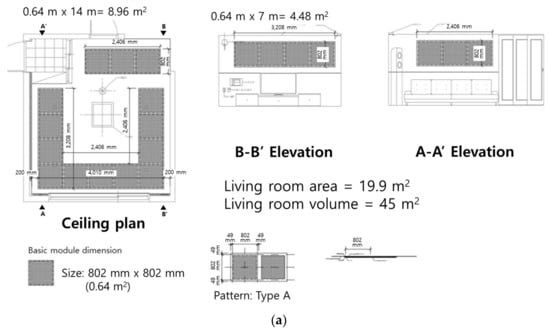
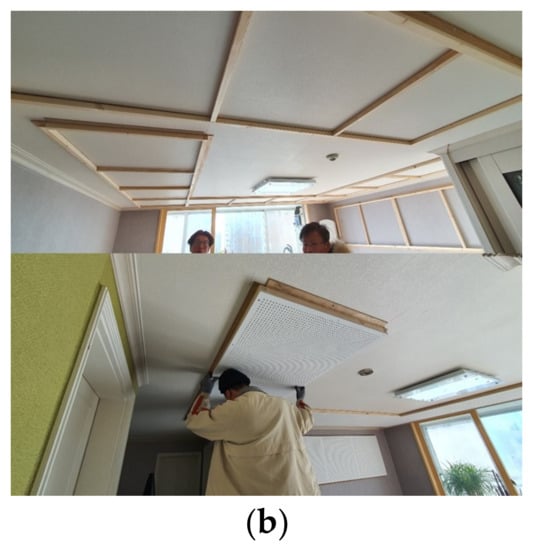
Figure 7.
Ceiling plan and elevations of the test specimen modules in the living room, including construction pictures. (a) Ceiling and elevation plan with the test specimen; (b) pictures of the receiving room with installing the test specimens on ceiling and walls.
2.4. Measurement and Evaluation Methods
2.4.1. Measurement Method
The test procedure on in situ sound insulation performance of heavy-weight impact sources followed KS F 2810-2 [26], which partially corresponded to ISO 16283-2 [27]. Two types of standard heavy-weight impact sound sources of bang machine and rubber ball were employed, as shown in Figure 8. Five impact and receiving points, including center position, were considered. Microphone height was 1.2 m according to the Korean mandatory regulation [28].
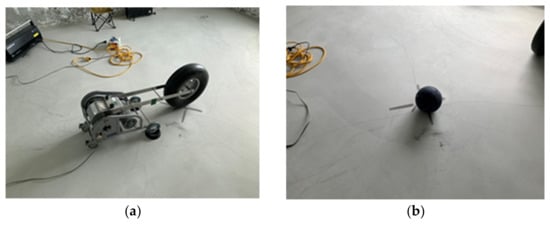
Figure 8.
Pictures of the standard heavy-weight impact sources in the box-type test building. (a) Bang machine; (b) rubber ball.
2.4.2. Evaluation Method
Single number quantity (SNQ), Li,Fmax,AW, was derived from the measured octave band maximum sound pressure levels at octave bands from 63 to 500 Hz in accordance with KS F 2863-2 [29], which partially corresponded to ISO 717-2 [30]. In South Korea, every apartment building should show a minimum reduction performance for heavy-weight impact sources as 50 dB or less in terms of Li,Fmax,AW [28].
2.5. Field Questionnaire Survey
To collect subjective responses on heavy-weight impact sources before and after installation of the test specimen in the actual apartment building, a simplified field questionnaire survey was carried out. Three subjective aspects of loudness, annoyance, and noisiness were asked to subject [31]. As for actual sound sources, running and walking situations with five children were given in the field survey, as shown in Figure 9a,b. The children’s ages ranged from 6 to 9 years old; children of those ages are known as the primary sources of floor impact sound [32]. The situation in which a child walks or runs is divided into 1 person, 3 people, and 5 people so that the change in impact force can be felt in the measuring room below. The standard impact sources were also employed, as shown in Figure 10. In the case of the rubber ball, a 0.3 m height dropping case was included to simulate soft impacts which frequently occur in everyday life, as shown in Figure 10c [12]. Ten 40–50-year-old subjects participated in the field survey. The number of subjects (10) was very small compared to general subjective experiments, but considering that it was an actual residential field condition, not a laboratory, it was tried to check whether the physical change of floor impact sound can be felt subjectively. The questionnaire consisted of three items of loudness, noisiness, and annoyance on a 7-point rating scale (from 1 not at all to 7 extremely) [8].
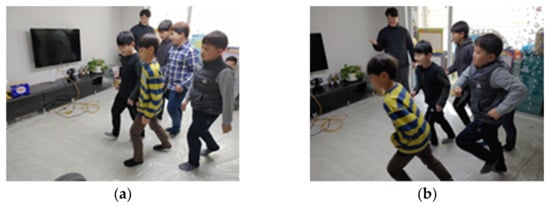
Figure 9.
Pictures of the actual impact sources employed in the actual apartment building: (a) 5 walking children; (b) 5 running children.

Figure 10.
Pictures of the standard impact sources employed in the actual apartment building. (a) Bang machine; (b) rubber ball dropping at 1 m height; (c) rubber ball dropping at 0.3 m height for simulating soft impact situation.
3. Results
3.1. Experiment I in the Box-Type Test Building
Table 3 shows the measurement results from experiment I in terms of SNQ values by KS F 2863-2. In the case of the bare ceiling, SNQ for the bang machine and rubber ball was 54 dB and 59 dB, respectively, as reference values to determine reduction levels by each treatment. From the test cases of (2-1) to (2-3), a flat ceiling with a wooden structure (40 mm thick) and gypsum board (9.5, 12.5, and 19 mm thick) showed all 53 dB for the bang machine SNQ, whereas SNQs for rubber ball showed 58 dB for 9.5 and 12.5 thickness of gypsum board and 57 dB for 19 mm thickness of gypsum board (two plies of 9.5 mm thick gypsum board). Therefore, 1 dB of heavy-weight impact noise reduction is expected in a flat ceiling compared to a bare ceiling. However, sound pressure levels only at 250–500 Hz were decreased, but those at 63–125 Hz were amplified. Variation of surface density seems not influential for heavy-weight impact noises.

Table 3.
The measurement results from experiment I in terms of SNQ values by KS F 2863-2. In (8-3) case, the rubber ball source was not employed due to technical reasons (N/A—not available).
In the case of multi-perforated gypsum boards with different hole patterns of (3-1) to (3-3), all three profiles of Type A, Type B, and Type C shows 50 dB of SNQ value for the bang machine, and from 54 to 55 dB of SNQ values for a rubber ball. In comparison to a normal flat ceiling case with a non-perforation gypsum board, 3 dB of heavy-weight impact noise reduction is expected. However, there was no significant difference in perforation patterns. When the glass wool sound absorber was placed behind multi-perforated gypsum boards as (4-1) case, an additional 1 and 2 dB of heavy-weight impact noise reduction was observed for bang machine and rubber ball, respectively, in comparison with (3-1) case.
In the case of the coffered ceiling, the non-perforation gypsum board of the (5-1) case showed 1 dB reduction for both bang machine and rubber ball in comparison with the flat ceiling of the (2-1) case. When replacing the center and corner area of the coffered ceiling with multi-perforated gypsum boards of (5-4) case, a maximum 1 dB reduction for bang machine and 4 dB reduction for rubber ball was observed comparing coffered ceiling with non-perforation gypsum board of (5-1) case. It seems that the installation amount of multi-perforated gypsum boards is relatively important rather than the installation location. In the case of the additional installation treatments, as shown in Figure 5, 50 mm thick Type A profile of (6-1) case showed 1 and 2 dB reduction for bang machine and rubber ball, respectively; 50 mm thick Type D profile of (6-2) case showed 2 and 4 dB reduction for bang machine and rubber ball, respectively. However, the 100 mm thick Type D profile of the (6-3) case showed no difference with the same module of 50 mm thick. Since Type A and Type D modules have a surface area of 6.48 m2 and 8.64 m2, respectively, it confirms the importance of installation amount. The wallpaper finish on the surface of the Type D module of the (7-1) case or perforation of the backing gypsum boards of the (8-1) case did not affect its noise reduction performances. However, water-based painting on the surface of the Type D module of the (7-2) case contributes to improving heavy-weight impact noise reduction performance by 1 dB. Whereas removal of backing non-woven fabric of the (8-2) case yielded amplification of heavy-weight impact noises by 1 dB. In addition, the installation of more sound absorbers on the wall and corner ceiling area of the (8-3) case was helpful to improve reduction performances in terms of the bang machine.
3.2. Experiment II in the Actual Apartment Building
Table 4 shows the measurement results from experiment II in terms of SNQ values by KS F 2863-2. Since SNQ for bang machine was measured as 56 dB and 57 dB before and after the test module installation, respectively, it was rather getting worse due to amplification of impact sounds at 1/1 octave bands of 63 Hz. For frequency characteristics in 1/3 octave bands, as shown in Figure 11a, impact noises at 63 Hz or more were reduced, but impact noises at 40–50 Hz were amplified. Therefore, this test module is not suitable where the target building shows dominant resonant properties at 63 Hz around, whereas SNQ for rubber ball was reduced by 2 dB as measured from 54 dB before the installation to 52 dB after the installation. Although a similar tendency of reduction at 80 Hz or more was observed for rubber ball in the same manner as the results from bang machine as shown in Figure 11b, reduction of SNQ could be shown for rubber ball impacts since the rubber ball has dominant frequency property at 125 Hz around. On the other hand, the use of the floor covering mattress showed an additional reduction of 3 dB for both bang machine and rubber ball. Since the Just Noticeable Difference (JND) of rubber ball is known as 2 dB [32], the employed treatments are expected to improve indoor acoustic environments for residents.

Table 4.
The measurement results from experiment II in terms of SNQ values by KS F 2863-2.

Figure 11.
Frequency characteristics of heavy-weight impact sounds in 1/3 octave bands from Experiment II. “W/O” refers the case No. (9), “W” refers the case No. (10-1), and “W+MAT” refers the case No. (10-2). (a) Bang machine; (b) rubber ball.
3.3. Subjective Impression of the Reduced Impact Sounds from the Field Questionnaire Survey
Figure 12 shows average scores of subjective responses in terms of loudness, noisiness, and annoyance. All results on loudness, noisiness, and annoyance highly correlated with each other. After the installation of the test modules, every sound source was perceived as less loud, less noisy, and less annoyed. The running situation showed higher scores than the walking situation, and impact noises from a greater number of children showed higher scores. Bang machine results are approximately corresponded to the running situation with five children, whereas rubber ball results approximately corresponded to the walking situation with five children or running situation with three children. In addition, the condition with floor covering mattress showed a dramatically decreased score.
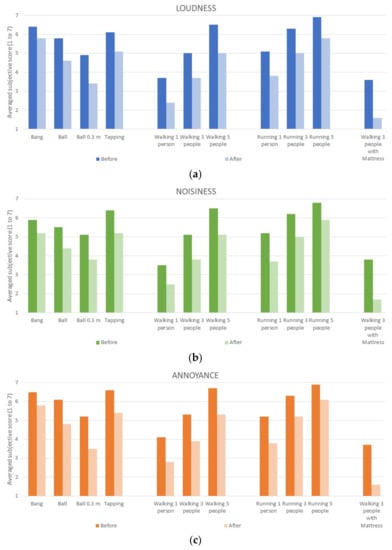
Figure 12.
Results of subjective impression of the reduced impact sounds from the field questionnaire survey. (a) Loudness; (b) noisiness; (c) annoyance.
4. Conclusions
In this study, the effectiveness of the sound absorptive modules made of multi-perforated gypsum boards was investigated in the box-type building, and then, it was verified in the actual apartment building with a subjective test. The main findings derived from this study can be summarized as follows:
- For the flat-type ceiling, application of multi-perforated gypsum boards without backing porous type sound absorbers can reduce heavy-weight floor impact noise up to 3 and 4 dB, respectively, for bang machine and rubber ball as sound sources.
- For the flat-type ceiling, the application of multi-perforated gypsum boards with backing porous type sound absorbers can reduce heavy-weight floor impact noise up to 4 and 5 dB, respectively, for bang machine and rubber ball as sound sources.
- For the flat-type ceiling, there was no significant difference of not more than 1 dB on heavy-weight floor impact noise according to thickness variation of non-perforated gypsum boards or perforation pattern variations.
- For the coffered-type ceiling with bang machine, application of multi-perforated gypsum boards only on the central coffered area can reduce heavy-weight floor impact noise by 1 dB.
- For the coffered-type ceiling with rubber ball, the application area of multi-perforated gypsum boards showed a proportional relationship with a reduced level of heavy-weight floor impact noise by up to 4 dB.
- For adding perforated gypsum board modules on coffered-type ceiling with non-perforated gypsum boards, Type A pattern was effective to reduce heavy-weight impact noise for bang machine source by up to 1 dB and Type D for rubber ball by up to 4 dB.
- As for finishing method of coffered ceiling surfaces, wallpaper finish was not effective, but water-based painting finish was effective to reduce heavy-weight impact noise by 1 dB.
- For the coffered-type ceiling, removal of backing non-woven fabric offset the reduction effects of multi-perforated gypsum boards on heavy-weight floor impact noise only for bang machine source.
From the findings, possibilities of reducing heavy-weight impact sounds using multi-perforated gypsum boards were confirmed. Application of the test modules could contribute to improving the reduction of performances of heavy-weight impact noise by up to 3 dB for bang machine and 5 dB for rubber ball. It was found that the number of installed modules is the most important factor in terms of surface area. In addition, design factors for reducing heavy-weight impact sounds with multi-perforated gypsum boards were discussed in accordance with the type of impact sound sources. From the actual apartment experiment, it was found that the sound absorptive module was mainly effective when the existing structure did not show dominant properties of impact noises at 63 Hz.
Since the existing typical solutions are concentrated on designing floating floor structures, it is not suitable for acoustic retrofitting of the aged apartment house. Therefore, obtaining a 2 dB reduction of heavy-weight impact sounds by reconstructing the ceiling using multi-perforated gypsum boards can improve the indoor acoustic environments of the existing apartment houses in a relatively simple way compared to a reconstruction of the floor structure. As a further study, more verifications are needed to optimize the module profile.
Funding
This research was financially supported by the Development for Regional Industry and the Technology Innovation Program (No. 10065698), funded by the Ministry of Trade, Industry, and Energy (MOTIE, Korea).
Institutional Review Board Statement
The study was conducted in accordance with the Declaration of Helsinki, and approved by the Institutional Review Board of Yongsan University (protocol code YSUIRB-201802-HR-044-02 and 12 February 2019).
Informed Consent Statement
Informed consent was obtained from all subjects involved in the study.
Data Availability Statement
Not applicable.
Acknowledgments
The author is grateful to Hye Mi Lee, So Young Kim, and Shinho Co., Ltd. for their great support.
Conflicts of Interest
The author declares no conflict of interest.
References
- Chen, H.; Jia, B.; Lau, S.S.Y. Sustainable urban form for Chinese compact cities: Challenges of a rapid urbanized economy. Habitat Int. 2008, 32, 28–40. [Google Scholar] [CrossRef]
- Cheshmehzangi, A. Housing and health evaluation related to general comfort and indoor thermal comfort satisfaction during the COVID-19 lockdown. J. Hum. Behav. Soc. Environ. 2021, 31, 184–209. [Google Scholar] [CrossRef]
- Rasmussen, B. Acoustic classification schemes in Europe—Applicability for new, existing and renovated housing. In Proceedings of the BNAM 2016, Stockholm, Sweden, 18–21 April 2016. [Google Scholar]
- ISO/TS 19488; Acoustics—Acoustic Classification of Dwellings. International Organization for Standardization: Geneva, Switzerland, 2021.
- LoVerde, J.; Dong, W. Developing Classifications using a Dual-Rating Method of Evaluating Impact Noise. In Proceedings of the INTER-NOISE 2018, Chicago, IL, USA, 26–29 August 2018; pp. 4569–4577. [Google Scholar]
- Jeong, J.H.; Kim, Y.H.; Ryu, J.K.; Kim, K.H. Classification scheme of floor impact sound insulation by rubber ball. In Proceedings of the INTER-NOISE 2020, Seoul, Korea, 23–26 August 2020; pp. 1139–1142. [Google Scholar]
- Shieko, M.; Lemos, E.; Monteiro, C. An approach on how an acoustic classification scheme for dwellings can be adopted in Brazil. In Proceedings of the Euronoise 2018, Crete, Greece, 27–31 May 2018; pp. 1133–1136. [Google Scholar]
- Jeon, J.Y.; Hong, J.Y.; Kim, S.M.; Lee, P.J. Classification of heavy-weight floor impact sounds in multi-dwelling houses using an equal-appearing interval scale. Build. Environ. 2015, 94, 821–828. [Google Scholar] [CrossRef]
- Brunskog, J.; Hwang, H.D.; Jeong, C.H. Subjective response to foot-fall noise, including localization of the source position. Acta Acust. United Acust. 2011, 97, 904–908. [Google Scholar] [CrossRef]
- Kim, K.W.; Shin, H.K. Floor Impact Sound Performance Variation in Old Apartment Housing. In Proceedings of the INTER-NOISE 2019, Madrid, Spain, 16–19 June 2019; pp. 5823–5828. [Google Scholar]
- Lee, W.H.; Song, G.G.; Kim, Y.H.; Yoon, Y.J. Reduction performance of floor impact sound of the existing apartment buildings in Korea. J. Acoust. Soc. Am. 2017, 141, 3775. [Google Scholar] [CrossRef]
- Kim, Y.H.; Song, G.G.; Lee, W.H.; Seo, J.B.; Kim, M.J.; Jeong, J.H.; Ryu, J.K.; Kim, K.H. A guideline of heavy-weight floor impact noise reduction for retrofitted apartment buildings in Korea. In Proceedings of the INTER-NOISE 2017, Hong Kong, China, 27–30 August 2017; pp. 5471–5478. [Google Scholar]
- Alonso, A.; Patricio, J.; Suárez, R.; Escandón, R. Acoustical retrofit of existing residential buildings: Requirements and recommendations for sound insulation between dwellings in Europe and other countries worldwide. Build. Environ. 2020, 174, 106771. [Google Scholar] [CrossRef]
- Maderuelo-Sanz, R.; Martín-Castizo, M.; Vílchez-Gómez, R. The performance of resilient layers made from recycled rubber fluff for impact noise reduction. Appl. Acoust. 2011, 72, 823–828. [Google Scholar] [CrossRef]
- Bouttout, A. Experimental study of the impact noise through concrete floor with resilient layers. J. Acoust. Soc. Am. 2017, 142, 2517. [Google Scholar] [CrossRef]
- Kim, Y.H.; Song, G.G.; Bae, S.K. Application of ETPU materials for reducing floor impact noises. In Proceedings of the Euronoise 2018, Crete, Greece, 27–31 May 2018; pp. 1723–1726. [Google Scholar]
- Cho, H.M.; Kim, S.T.; Kim, M.J. Experimental Study on the Reduction Performance of Floor Impact Sound according to Reduction Method of Floor Structure Layers in Aged-Apartment. In Proceedings of the INTER-NOISE 2018, Chicago, IL, USA, 26–29 August 2018; pp. 2753–2758. [Google Scholar]
- Ryu, J.K.; Song, H.S.; Kim, Y.H. Effect of the suspended ceiling with low-frequency resonant panel absorber on heavyweight floor impact sound in the building. Build. Environ. 2018, 139, 1–7. [Google Scholar] [CrossRef]
- Park, H.G.; Mun, D.H. Characteristics of Floor Impact Noise Insulation for No Hanger Ceiling Structure in Apartment Building. Proc. Korean Soc. Noise Vib. Eng. 2014, 208–213. Available online: http://www.koreascience.or.kr/article/CFKO201431749164412.view (accessed on 18 March 2022).
- Kim, K.W.; Kang, J.S.; Lee, S.E.; Yang, K.S. Floor Impact Sound Isolation Performance by Composition of Ceiling and Wall. Trans. Korean Soc. Noise Vib. Eng. 2005, 15, 465–473. [Google Scholar]
- Song, H.S.; Ryu, J.K.; Kim, I.H.; Kim, Y.H.; Song, G.G. Evaluation of Impact Sound Insulation by Sound Absorbing Materials inside Ceiling through Mock-up Test in Reverberation Chamber. Proc. Korean Soc. Noise Vib. Eng. 2018, 155. Available online: https://www.dbpia.co.kr/journal/articleDetail?nodeId=NODE07555332 (accessed on 18 March 2022).
- Jeon, J.Y.; Jeong, J.H.; Park, H.J. Subjective Evaluation of Floor Impact Noise Isolation Construction for Floor, Wall and Ceiling. J. Archit. Inst. Korea Plan. Des. 2002, 18, 169–176. [Google Scholar]
- Kim, K.H.; Choi, H.J.; Kim, Y.G. Evaluation of ceiling structure influencing to the floor impact sound. Proc. Korean Soc. Noise Vib. Eng. 2011, 423–424. Available online: http://koreascience.or.kr/article/CFKO201125752339367.page (accessed on 18 March 2022).
- Kim, I.H.; Go, J.C. Effects of Finishing Materials in Wall and Ceiling on Floor Impact Sound. In Proceedings of the INTER-NOISE 2016, Hamburg, Germany, 21–24 August 2016; pp. 7512–7517. [Google Scholar]
- Shin, H.K.; Kim, K.W. Floor Impact Sound Insulation Using Perforated Gypsum Board Ceiling. In Proceedings of the INTER-NOISE 2019, Madrid, Spain, 16–19 June 2019; pp. 5848–5853. [Google Scholar]
- KS F 2810-2; Field Measurements of Floor Impact Sound Insulation of Buildings―Part 2: Method Using Standard Heavy Impact Sources. Korean Agency for Technology and Standards: Eumseong, Korea, 2012.
- ISO 16283-2; Acoustics—Field Measurement of Sound Insulation in Buildings and of Building Elements—Part 2: Impact Sound Insulation. International Organization for Standardization: Geneva, Switzerland, 2018.
- Act No. 2020-212; Criteria for Recognition and Management of Floor Impact Sound Interception Structure in Apartment Houses. Ministry of Land, Infrastructure and Transport: Sejong Special Governing City, Korea, 2020.
- KS F 2863-2; Rating of Floor Impact Sound Insulation for Impact Source in Buildings and Building Elements—Part 1: Floor Impact Sound Insulation against Standard Heavy Impact Source. Korean Agency for Technology and Standards: Eumseong, Korean, 2017.
- ISO 717-2; Acoustics—Rating of Sound Insulation in Buildings and of Building Elements—Part 2: Impact Sound Insulation. International Organization for Standardization: Geneva, Switzerland, 2020.
- Hellman, R.P. Loudness, annoyance, and noisiness produced by single-tone-noise complexes. J. Acoust. Soc. Am. 1982, 72, 62–73. [Google Scholar] [CrossRef] [PubMed]
- Jeon, J.Y.; Ryu, J.K.; Tachibana, H. Review of the Impact Ball in Evaluating Floor Impact Sound. Acta Acust. United Acust. 2006, 92, 777–786. [Google Scholar]
Publisher’s Note: MDPI stays neutral with regard to jurisdictional claims in published maps and institutional affiliations. |
© 2022 by the author. Licensee MDPI, Basel, Switzerland. This article is an open access article distributed under the terms and conditions of the Creative Commons Attribution (CC BY) license (https://creativecommons.org/licenses/by/4.0/).